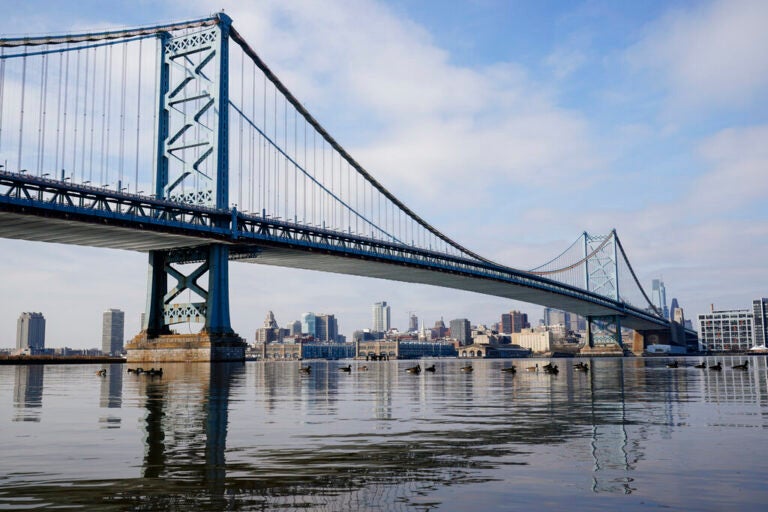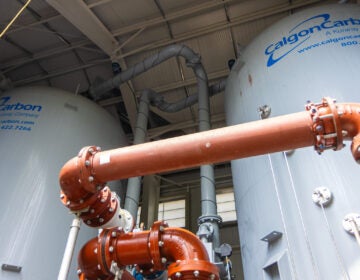EPA proposes new water quality standards for fish living in the Delaware River
Environmentalists have been calling for improved water quality for the endangered Atlantic Sturgeon for more than a decade.
Listen 1:07
File photo: The Benjamin Franklin Bridge spanning the Delaware River between Camden N.J., foreground, and Philadelphia is seen, Wednesday, Feb. 10, 2021. (AP Photo/Matt Rourke)
From Philly and the Pa. suburbs to South Jersey and Delaware, what would you like WHYY News to cover? Let us know!
The Environmental Protection Agency has proposed new water quality standards that aim to protect fish in a portion of the most populated parts of the Delaware River.
Some fish traveling the river between Philadelphia, South Jersey, and Wilmington struggle to survive and thrive due to low dissolved oxygen levels caused by ammonia discharges from wastewater facilities.
This urban stretch of the Delaware River is the only section of the region’s waterways that isn’t fully protective of aquatic life, according to the EPA, and oxygen level criteria doesn’t meet Clean Water Act standards.
Environmental groups have been calling for improved fish protections in the Delaware River for more than a decade, voicing concerns about the federally endangered Atlantic Sturgeon.
“This proposed rule takes an important step toward protecting endangered species and promoting healthy waterways for the aquatic life that depend on them,” said EPA Administrator Michael S. Regan in a statement.
The EPA is proposing federal standards that determine the levels of oxygen fish need in order to flourish along 38 miles of the Delaware River. The agency also proposes updating protections for fish of all life stages, including fertilized eggs and larval stages.
Standards around dissolved oxygen levels have not been updated for 50 years. Scientists have called on the Delaware River Basin Commission, which oversees the region’s water quality, to increase its 1967 criteria for dissolved oxygen levels.
The Clean Water Act aims to ensure waterways are safe for aquatic life, and any standards that don’t meet that goal must be reevaluated periodically and updated when more protective standards are attainable, said Greg Voigt, an environmental scientist with the EPA.
“The current standards for dissolved oxygen … are not intended to protect the various stages of native fish species that inhabit this river,” he said. “Particularly, they’re not protective of juvenile life stages.”
EPA Mid-Atlantic Regional Administrator Adam Ortiz said he believes protections in the Delaware River lag behind other waterways. While current standards protect fish passage, they don’t meet the “fishable” goals outlined in the Clean Water Act, Ortiz said.
“The announcement today is a step towards healing that breach to making sure that no matter where you are in our region or where you are in this country, that you’re entitled to a healthy and beautiful and vibrant natural environment,” he said.
The EPA said once dissolved oxygen standards are enacted, it will help sewage facilities install treatment technologies to remove more ammonia before discharging the wastewater into the river. These improvements could cost more than $137 million per year overall, Ortiz said.
Facilities in other regions have already implemented ammonia treatment systems, and the city of Philadelphia plans to do the same.
The Philadelphia Water Department has applied for a low-interest PennVest state loan to help fund a $74-million facility to reduce ammonia discharged from its highest emitter, the Southwest Water Pollution Control plant, which discharges into the Delaware River.
In a statement, the Water Department said it shares the EPA’s goal of protecting the Atlantic Sturgeon and other fish species.
“PWD looks forward to working with EPA and other stakeholders to better understand the threats to sturgeon,” the statement reads. “Together we hope to identify additional water quality improvements based on sound science, technologically feasible and, especially, equitable, and affordable for our ratepayers.”
The EPA will take public comment on its proposal over the next 60 days.
The Delaware Riverkeeper Network, which petitioned the EPA to implement more stringent water quality standards for fish, said the proposal is a positive first step. Though the proposal would increase dissolved oxygen criteria previously set by the DRBC, the activist group urges the EPA to go further.
“Unfortunately, while the EPA took an important step forward, they did not set the numbers as high as the science dictates and the Sturgeon of the Delaware River need,” said Maya van Rossum of the Delaware Riverkeeper Network in a statement. “It is essential … the EPA takes full stock of the science and lifts their standards to the degree necessary to ensure future generations are able to enjoy witnessing a live, healthy, and free-swimming Delaware River Atlantic Sturgeon.”
The DRBC said it will continue to work with the EPA and stakeholders to plan for the implementation of the new water quality standards.
“As water bodies around the country struggle to achieve and maintain measurable water quality improvements that balance ecological needs with economic growth and water affordability, the Delaware River Estuary is a model for federal and interstate collaboration on shared clean water goals,” DRBC Executive Director Steve Tambini said in a statement.

Get daily updates from WHYY News!
WHYY is your source for fact-based, in-depth journalism and information. As a nonprofit organization, we rely on financial support from readers like you. Please give today.






